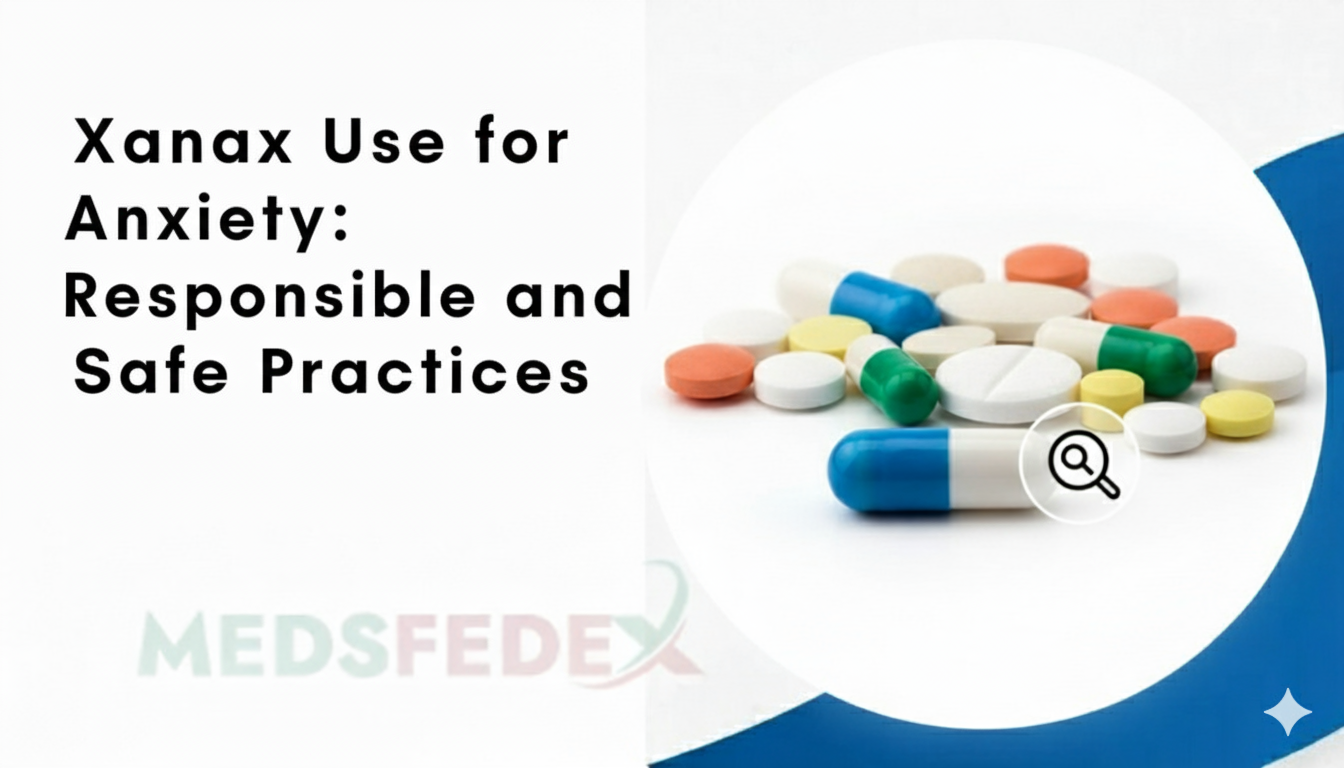
Navigating Anxiety in Today’s World
Picture this: you wake up, and the world feels daunting. The weight of anxiety creeps in, making simple tasks seem insurmountable. You’re not alone—anxiety disorders are becoming increasingly prevalent, affecting millions across various demographics. According to recent studies, approximately 30% of adults in the U.S. will experience an anxiety disorder at some point in their lives, highlighting the critical need for effective management strategies.
Untreated anxiety can lead to significant impairments in daily life. From difficulties in maintaining relationships to challenges at work, the repercussions can be profound. Furthermore, the stigma surrounding mental health often prevents individuals from seeking help. For those considering medication, understanding where to safely procure Xanax can be a crucial step toward recovery. By the end of this article, you’ll know how to navigate the complexities of anxiety management, including responsible Xanax use. Let’s dive into the top practices that can help you manage anxiety effectively.
The Anxiety Epidemic: Why It Matters
The rise in anxiety disorders is a pressing issue in modern society. Studies indicate that anxiety affects individuals of all ages, with symptoms ranging from mild worry to debilitating panic attacks. Imagine a day in the life of someone living with anxiety: they might wake up feeling a knot in their stomach, dread social interactions, or struggle to focus at work. The implications are significant, often leading to isolation and a decreased quality of life.
Understanding the scope of anxiety can motivate readers to seek help and explore treatment options. Recognizing that anxiety is not just a personal struggle but a widespread issue can foster a sense of community and support. For those considering medication, understanding where to safely procure Xanax can be a crucial step toward recovery. This knowledge can empower individuals to make informed decisions about their mental health.
Decoding Xanax: What You Need to Know
Understanding Xanax: The Basics
Xanax, known generically as alprazolam, is a benzodiazepine that effectively manages anxiety and panic disorders. It works by enhancing the effects of a neurotransmitter called gamma-aminobutyric acid (GABA), which promotes relaxation and reduces excessive neural activity. Typically prescribed for short-term management, Xanax can provide rapid relief from anxiety symptoms, often taking effect within an hour.
Many patients find that after starting Xanax, they experience a significant reduction in anxiety symptoms, allowing them to engage more fully in their daily lives. However, it’s essential to use Xanax under medical supervision to prevent dependency and withdrawal issues. Recognizing how Xanax works can help users appreciate its intended use and the importance of following prescribed guidelines.
Pros and Cons of Xanax Usage
While Xanax is effective for many, it comes with both benefits and risks that must be carefully considered. On the positive side, Xanax can provide rapid relief from anxiety symptoms, making it a valuable tool for those in crisis. However, the potential for dependency is a significant downside, especially with long-term use. Many users discover that while Xanax alleviates their anxiety, it can also lead to a cycle of reliance.
For instance, a patient might successfully manage their anxiety with Xanax but later face challenges when trying to discontinue use due to withdrawal symptoms. This highlights the importance of awareness regarding both the benefits and risks of Xanax usage. Understanding these dynamics can guide users in their treatment journey, enabling them to make informed decisions about their mental health.
Explore Trusted Treatment Options — Buy Xanax Online
Guidelines for Safe Xanax Use
Adhering to Prescriptions: A Vital Step
Following prescribed guidelines is essential for safe Xanax use. Healthcare providers play a crucial role in monitoring treatment, adjusting dosages, and providing necessary support. Adhering to a prescribed regimen can significantly enhance the effectiveness of Xanax while minimizing risks. Patients who consistently follow their prescriptions are more likely to achieve positive outcomes.
Consider a patient who diligently follows their prescribed dosage and maintains regular consultations with their healthcare provider. This proactive approach not only helps manage anxiety but also builds a trusting relationship with their doctor, facilitating better treatment outcomes. Understanding the importance of adherence can lead to improved mental health and well-being.
Recognizing Misuse: Staying Vigilant
Users must be aware of the signs of misuse associated with Xanax. Common indicators include taking higher doses than prescribed, using the medication without a prescription, or experiencing adverse effects without reporting them to a healthcare provider. Staying vigilant can prevent potentially dangerous situations and ensure that users maintain a healthy relationship with their medication.
For example, a user who begins to experience increased anxiety relief but also heightened drowsiness may be misusing their medication. Recognizing these signs and seeking help can mitigate risks and enhance safety when using Xanax. Being informed about the potential for misuse is crucial for anyone considering or currently using this medication.
Recognizing Risks: Side Effects of Xanax
Common Side Effects: What to Watch For
Xanax can lead to various side effects that users should monitor closely. Common side effects include drowsiness, dizziness, and cognitive impairment. For instance, a user may find themselves feeling unusually sleepy during the day, which can impact their work and personal life. Being aware of these side effects is essential for managing one’s treatment effectively.
In cases where side effects become problematic, consulting with a healthcare provider is crucial. They can offer guidance on how to manage these effects or adjust the treatment plan if necessary. Being informed about side effects can help users navigate their experiences with Xanax more effectively, ensuring they maintain their overall well-being while managing anxiety.
Dependency and Withdrawal: Understanding the Risks
Long-term use of Xanax can lead to dependency and withdrawal symptoms if not managed correctly. Users should recognize the signs of dependency, which may include cravings, increased tolerance, and withdrawal symptoms when not taking the medication. Understanding these risks is vital for anyone considering or currently using Xanax.
For example, a user who has taken Xanax for several months may find it challenging to stop without experiencing withdrawal symptoms like increased anxiety or insomnia. This underlines the importance of gradual dosage reduction under medical supervision to minimize withdrawal risks. Awareness of dependency issues can encourage safer practices and better outcomes for those using Xanax.
Exploring Alternatives to Xanax for Anxiety Management
Holistic Approaches: Embracing Natural Relief
Many individuals find relief through non-pharmaceutical methods for managing anxiety. Options such as cognitive-behavioral therapy (CBT), mindfulness practices, and lifestyle changes can be effective alternatives or complements to medication. For instance, a patient may engage in CBT to address thought patterns contributing to their anxiety, finding significant relief without medication.
Exploring these alternatives can provide individuals with additional tools for managing anxiety. Many people discover that incorporating mindfulness techniques, like meditation or yoga, into their routine helps reduce anxiety levels naturally. Embracing these holistic approaches can lead to improved mental health outcomes and a better overall quality of life.
Balancing Medication and Alternatives
Finding the right balance between medication and alternative approaches is key to effective anxiety management. Users can integrate therapy with medication for comprehensive treatment. For example, a user who combines regular therapy sessions with Xanax usage may achieve optimal results, addressing both the symptoms and underlying causes of their anxiety.
This balanced approach can enhance overall well-being and provide individuals with a more robust toolkit for managing anxiety. Empowering users to explore various strategies and find what works best for them is essential in the journey toward better mental health.
The Power of Support: Building Your Network
Finding Your Tribe: The Importance of Community
Support networks play a crucial role in managing anxiety. Engaging with support groups, friends, and family can provide emotional support and practical advice for those suffering from anxiety. For instance, a person who attends a local support group may find comfort in sharing experiences with others facing similar challenges.
Building a supportive community can significantly enhance coping strategies and foster a sense of belonging. Encouraging readers to seek out and cultivate these connections is vital for their mental health. Knowing that they are not alone in their struggles can empower individuals to face their anxiety more effectively.
Overcoming Stigma: Embracing Vulnerability
Many individuals feel isolated due to the stigma associated with anxiety. Overcoming this stigma is crucial for seeking and receiving support. For example, someone might initially hesitate to discuss their anxiety with friends or family due to fear of judgment. However, embracing vulnerability and sharing their experiences can lead to stronger support systems and improved mental health.
Encouraging readers to break down these barriers and seek help is essential for fostering a supportive environment. Embracing vulnerability can empower individuals to connect with others, enhancing their recovery journey.
Connect With Certified Providers Now — Buy Xanax Online
Putting It All Together
Responsible practices in Xanax use and awareness of alternatives are essential for effective anxiety management. This article has highlighted the importance of adhering to prescribed guidelines, recognizing potential risks, and exploring holistic approaches alongside medication. By integrating these strategies, individuals can take control of their anxiety management journey.
As you reflect on your experiences, consider what strategies might work best for you. Whether it’s through medication, therapy, or building a support network, the key is to find a personalized approach that promotes your mental well-being. For those who decide to explore Xanax as a treatment option, safe avenues to White Xanax Bars 2mg are available.
Empower yourself with knowledge and seek the support you need to navigate your anxiety successfully. Remember, you are not alone in this journey. Learn more about our services and how we can assist you in managing your mental health effectively.
FAQs – Professional, Clear & Blog-Optimized
What does Xanax do and how does it work?
Ans. Xanax (alprazolam) is a prescription medication from the benzodiazepine class, commonly used to manage anxiety and panic disorders.
It works by enhancing the effects of GABA (Gamma-Aminobutyric Acid), a neurotransmitter that naturally calms the brain.
By increasing GABA activity, Xanax helps reduce symptoms such as anxiety, tension, restlessness, and sudden panic episodes.
It should only be taken under the guidance of a licensed healthcare provider.
Is Xanax a narcotic or opioid?
Ans. No. Xanax is neither a narcotic nor an opioid.
It belongs to the benzodiazepine family, which works differently from opioids and is used primarily for anxiety-related conditions.
Although it is not an opioid, Xanax is still a controlled substance due to the possibility of dependence or misuse.
This is why it must only be used with a valid prescription and proper medical supervision.
Does Xanax calm you immediately?
Ans. Xanax is considered a fast-acting medication.
Most people begin to feel its calming effects within 15 to 60 minutes after taking a dose.
However, the exact onset time varies depending on factors such as metabolism, dosage, and individual response.
Even though the relief can be quick, it should always be taken exactly as prescribed.
What is the biggest side effect of Xanax?
Ans. The most common and notable side effect of Xanax is drowsiness or sedation.
Other possible side effects may include:
-
dizziness
-
slowed reaction time
-
memory problems
-
difficulty with coordination
-
dependency if used long-term or improperly
If any side effect becomes severe or unusual, medical advice should be sought right away.
Is Xanax safe to take for anxiety?
Ans. Xanax can be safe and effective for short-term anxiety relief when used appropriately and under medical supervision.
It is not recommended for long-term daily use because it can lead to dependence or tolerance over time.
Healthcare providers typically prescribe Xanax for temporary relief or as part of a broader treatment plan that may include therapy or long-term medications.
Enjoy Flat 10% Discount Using Code SALE10 Only on – Medsfedex.com
Written by meds fedex
Coupon Code
Use Coupon CodeSALE10
Check Details On Payment Page
Products Categories
-
 Buy Adderall Online
Buy Adderall Online -
 Buy Adipex Online
Buy Adipex Online -
 Buy Alprazolam Online
Buy Alprazolam Online -
 Buy Ambien Online
Buy Ambien Online -
 Buy Ativan online
Buy Ativan online -
 Buy Carisoprodol Online
Buy Carisoprodol Online -
 Buy Clonazepam Online
Buy Clonazepam Online -
 Buy Codeine Online
Buy Codeine Online -
 Buy Darvocet Online
Buy Darvocet Online -
 Buy Demerol Online
Buy Demerol Online -
 Buy Diazepam Online
Buy Diazepam Online -
 Buy Dilaudid Online
Buy Dilaudid Online -
 Buy Fioricet online
Buy Fioricet online -
 Buy Gabapentin Online
Buy Gabapentin Online -
 Buy Hydrocodone Online
Buy Hydrocodone Online -
 Buy Hydromorphone Online
Buy Hydromorphone Online -
 Buy Klonopin Online
Buy Klonopin Online -
 Buy Lexapro Online
Buy Lexapro Online -
 Buy Lorazepam Online
Buy Lorazepam Online -
 Buy Lorcet Online
Buy Lorcet Online -
 Buy Lortab Online
Buy Lortab Online -
 Buy Meridia Online
Buy Meridia Online -
 Buy Methadone Online
Buy Methadone Online -
 Buy Modafinil Online
Buy Modafinil Online -
 Buy Norco Online
Buy Norco Online -
 Buy Opana ER Online
Buy Opana ER Online -
 Buy Oxycodone Online
Buy Oxycodone Online -
 Buy Oxycontin Online
Buy Oxycontin Online -
 Buy Percocet Online
Buy Percocet Online -
 Buy Phentermine Online
Buy Phentermine Online -
 Buy Roxicodone Online
Buy Roxicodone Online -
 Buy Soma Online
Buy Soma Online -
 Buy Suboxone Online
Buy Suboxone Online -
 Buy Subutex Online
Buy Subutex Online -
 Buy Tapentadol Online
Buy Tapentadol Online -
 Buy Tramadol Online
Buy Tramadol Online -
 Buy Valium Online
Buy Valium Online -
 Buy Viagra Online
Buy Viagra Online -
 Buy Vicodin Online
Buy Vicodin Online -
 Buy Xanax Online
Buy Xanax Online -
 Buy Zolpidem Online
Buy Zolpidem Online

Leave a Reply